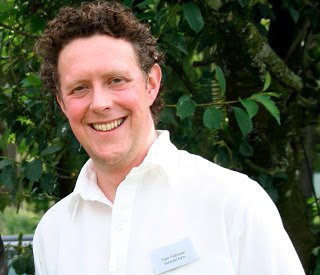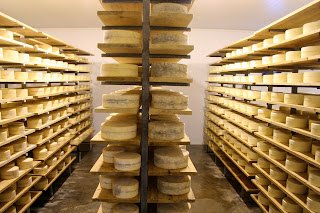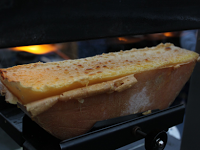It all started with a
caravan and a field full of llamas. That was back in 1995 when fresh
faced archaeology graduate Todd Trethowan first learned how to make
Caerphilly during an apprenticeship with the late Chris Duckett in
Somerset.
As well as being a
third generation cheesemaker and one of the last farmhouse Caerphilly
makers in the country, Duckett was was also a keen llama enthusiast
with a field full of the beasts, which is where the young Trethowan
ended up staying.
“I worked for him for
six months, living in my caravan surrounded my llamas. I didn't have
a car so every time I had to go to the dairy I had to take my
chances,” laughs Trethowan. “I used to come back from the pub at
night and they certainly weren't the friendliest. They are pretty
aggressive animals!”
Trethowan was hardly a
cheese novice when he arrived at Duckett's. Before going to
univeristy, he had worked for Neal's Yard in London and had paid his
way through college by working for cheesemakers such as Dougal
Campbell at Tyn Grug and Charlie Westhead at Neal's Yard Creamy. But
it was his time with Duckett that really laid the foundations for
Trethowan to set up his own dairy at the family farm in Ceredigion,
West Wales, which is where he still makes his unpasteurised Gorwydd
Caerphilly today. Duckett sadly passed away in 2009, but his cheese
is still made at Westcombe Dairy.
“I learned absolutely
everything from Chris. Every night I would come back to my caravan
with a big list of all the things I'd learned that day. I really made
the most of my time there and I've tried to be faithful to what he
taught me.”
 |
| Todd Trethowan: 'People told us not to make Caerphilly' |
Sixteen years later and
Trethowan says he is still learning, which is partly why the company
continues to only make Gorwydd Caerphilly. “I don't feel like we'll
ever have it beaten. If we made loads of cheeses we might take our
finger off the pulse and the cheese might go off the boil. We've
always been a very consistent cheese and I think we're getting
better.”
Run by Trethowan and
his wife Jess in partnership with his brother Maugan and his wife Kim
(who used to work for Neal's Yard Dairy), Trethowan's Dairy makes
around forty of the four kilo cheeses each day. These are dry salted
in their moulds and then brined, before being matured for around two
months.
The final cheese has a
velvety grey rind and two-tone interior, comprising a creamy outer
layer called 'the breakdown' and a firm but moist centre layer. Each
element adds a different flavour with lemony notes from the central
stripe, creamy mushroomy flavours from the breakdown and an
earthiness from the rind itself.
Gorwydd follows in the
tradition on the original farmhouse cheeses that were popular with
Welsh miners, who legend has it ate the cheese to replace the salt
they had lost through sweating. It's a million miles away from the
crumbly block Caerphilly on supermarket shelves that is almost
indistinguishable from factory-made Cheshire and Lancashire.
“There's no
comparison between a block Caerphilly and us, but it was something to
overcome when we first started,” says Trethowan. “People told us
not to make a Caerphilly and to do something more exotic. When we
were at markets people would say, 'Oh, we don't like Caerphilly'.
You'd give them a bit and they'd take a taste. Because the flavour
doesn't hit you straight away, they'd be walking away and then peel
round in a U-shape and come back to you, saying, “What was that
again?' We have to do far less convincing these days. People have
been won over.”
The company still has
market stalls at Borough and St Nicholas in Bristol, where it serves
'the ultimate cheese toastie', made with Keen's cheddar, and raclette
using Montgomery's Ogleshield (right). It also attends festivals, including
last year's Glastonbury, and runs regular cheese tastings and talks
with food and drink writer (and fellow cheese blogger) Fiona Beckett as part of The CheeseSchool. The company's main business, however, is selling through
delis, farm shops and cheesemongers, plus Waitrose, as well as at its
own own store in Bristol, which opened four years ago.
“We wanted to be one
of our biggest customers, but we also have a range of around 15 other
cheeses from people we've worked with over the years. It means we can
talk about them with some authority because we know how the cheeses
are made and how they should taste. Having a small range of cheeses
mean we can also sell them in really good nick. As a cheesemaker
myself, I feel honour-bound to sell someone else's cheese in
brilliant condition. I'd be mortified if I didn't.”
www.trethowansdairy.co.uk
* This article first appeared in the May 2012 issue of Fine Food Digest
www.trethowansdairy.co.uk
* This article first appeared in the May 2012 issue of Fine Food Digest





No comments:
Post a comment